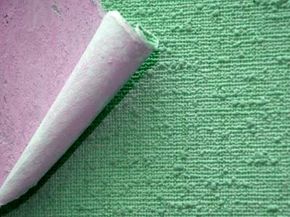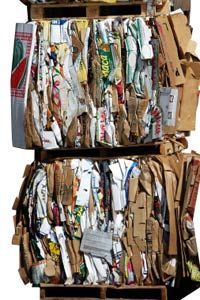 “Fabric-coated wallpaper and vinyl wallpaper may emit volatile organic compounds. See more pictures of hidden home dangers.©iStockphoto/Cherry-Merry
“Fabric-coated wallpaper and vinyl wallpaper may emit volatile organic compounds. See more pictures of hidden home dangers.©iStockphoto/Cherry-Merry
Exiled to the island of St. Helena for the last years of his life, Napoleon Bonaparte most likely died from arsenic poisoning. But no one secretly laced the disgraced former emperor’s food or drink. Surprisingly, the stealthy murderer may have been his wallpaper [source: Kevles].
That’s right. Wallpaper.
In the early 19th century, certain pigments used in wallpaper patterns contained arsenic. A contemporary Italian scientist discovered that bacteria that grew in flour-based wallpaper paste could react with the arsenic and cause it to evaporate into the air [source: Kevles]. Hence, Bonaparte’s colorful wall coverings may have paved the way to his ultimate demise.
Wallpaper on the market today isn’t packed with life-threatening arsenic. But it does bring up an important point about the effect of wallpaper on indoor air quality. Paint manufacturers are now selling low-VOC paints to clean up the toxins we can literally smell in that distinct fresh paint odor. Combined with the chemical adhesives used to attach to surfaces, some wallpapers have their own set of questionable additives.
One common type of wallpaper we purchase is made of vinyl [source: Bold-Pryor and Lacis]. Fabric-coated wallpaper is also treated with a vinyl or acrylic coating [source: Bold-Pryor and Lacis]. Vinyl (also known as PVC) is a plastic derived from petroleum, and quickly spells trouble for environmentalists. Also, vinyl is known to emit volatile organic compounds (VOCs), like certain paints do. These carbon compounds react with particles in the air to create ozone. Solvent-based inks also contribute to VOC emissions, although the VOC levels in wallpapered rooms are usually lower than those in painted ones [source: Carroll].
Perhaps the most significant environmental impact of wallpapers is the source of the pulp that makes the paper. Virgin timber may be stripped in the process, degrading the quality of the surrounding landscape. In response, the Forest Stewardship Council has developed a seal of approval for wallpapers that are made from recycled wood pulp or wood from sustainably managed forests.
But run-of-the-mill recycled paper isn’t the only way to green your wall décor. There are a host of items in lying around your house that companies are recycling into chic, eye-catching wallpaper.
Eco-Wallpaper
 “Recycled paper products can be converted into wallpaper.©iStockphoto/PenelopeB
“Recycled paper products can be converted into wallpaper.©iStockphoto/PenelopeB
Try as we may to lose the habit, Americans are paper addicts. The typical office worker scribbles away on 10,000 sheets of copy paper every year, and our annual collective paper usage averages out to the equivalent of one 100-foot (30-meter) Douglas fir tree per person [source: Environmental Protection Agency].
On the up side, we also recycle a lot of paper products — about 50 percent of paper, 72 percent of corrugated cardboard and 88 percent of newspaper, to be more precise [source: Environmental Protection Agency]. Some of that recycled wood pulp goes into producing more environmentally friendly wallpaper. One innovative eco-wall covering created entirely from recycled paper is V2 tiles by Mio [source: Brownell]. You can arrange these 3-D tiles in various ways to add dynamic texture and shape.
As mentioned on the previous page, green manufacturers are getting remarkably innovative in designing wallpaper. In addition to the napkins, toilet paper, tissues and other paper products that can be resurrected as wallpaper, here are a few unexpected recycled products that can end up on your walls:
- Phone books: Pallas Textiles is recycling Japanese phone books for 50 to 70 percent of the pulp in its Dial Tones natural wallpaper [source: Pallas Textiles]. Consumers can choose from a range of four speckled Earth tones.
- Diapers: Disposable diapers are composed of wood pulp and plastics. A British recycling company, Knowaste, sanitizes and recycles diapers to extract those resources. The wood pulp from diapers can then be distributed for manufacturing wallpaper, among other products [source: TreeHugger].
- Glass: Glass wallpaper may sound unfeasible, but Trend USA begs to differ. Its collection has the appearance of dazzling custom mosaics and is made from post-consumer recycled glass.
To add a finishing green touch to your new wall coverings, try your hand at mixing up homemade wallpaper paste. All you need is some flour, water and a couple of other ingredients to hang your eco-wallpaper with green, guilt-free bliss. Many Web sites offer simple-to-follow recipes for the paste.
If that earlier anecdote about Napoleon has you concerned about the interaction of flour in homemade paste and the dyes in eco-wallpaper, rest easy. Unlike the stuff that may have killed the French ruler, many green wallpapers are patterned with nontoxic, water-based ink.
Lots More Information
Related HowStuffWorks Articles
- How Skylights Work
- Why does a flooded house need to be torn down?
- How Daylighting Devices Work
- What’s so special about Integrity Block?
- How is ceramic tile made?
Sources
- Bold-Pryor, Ann and Lacis, Donna V. "The Naked Wall." Watson-Guptill. 2006. (April 10, 2009)http://books.google.com/books?id=ZHpzOu14DE8C
- Brownell, Blaine Erickson. "Transmaterial." Princeton Architectural Press. 2006. (April 10, 2009)http://books.google.com/books?id=IhSfzEqb–cC
- Carroll, Joyce. "Paint, Wallpaper and Indoor Air Quality." Bob Vila. (April 10, 2009)http://www.bobvila.com/HowTo_Library/Paint_Wallpaper_and_Indoor_Air_Quality-Healthy_Home-A2485.html
- Environmental Protection Agency. "Paper Recycling: Frequent Questions." Updated Sept. 30, 2008. (April 10, 2009)http://www.epa.gov/solidwaste/conserve/materials/paper/faqs.htm
- Goldsmith. Sheherazade. "Eco Wallpaper Is On a Roll." The Guardian. Aug. 9, 2008. (April 10, 2009)http://www.dailymail.co.uk/home/you/article-1041737/Eco-wallpaper-roll.html
- Kevles, Daniel J. "A history of poison." Slate. April 6, 2006. (April 10, 2009)http://www.slate.com/id/2139414/
- Koerner, Preston. "New Post-Consumer Recycled Glass Mosaic Tile Just Like Wallpaper." Jetson Green. Jan. 26, 2009. (April 10, 2009)http://www.jetsongreen.com/2009/01/new-post-consumer-recycled-glass-mosaic-tile-just-like-wallpaper.html
- Thomas, Justin. "DialTones by Pallas." TreeHugger. Aug. 25, 2005. (April 10, 2009)http://www.treehugger.com/files/2005/08/dialtones_by_pa.php
- TreeHugger. "New Diaper Recycling Technology to be Launched." May, 27, 2005. (April 10, 2009)http://www.treehugger.com/files/2005/05/new_diaper_recy.php

































